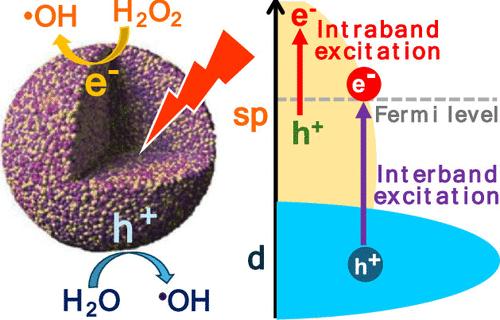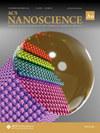等离子双金属纳米粒子的带间和带内热载流子驱动光催化:金-铜合金纳米粒子的案例研究
IF 4.8
Q2 NANOSCIENCE & NANOTECHNOLOGY
引用次数: 0
摘要
金属纳米粒子中的光激发非热电子和空穴被称为热载流子,可被明智地利用来驱动纳米粒子表面有趣的光催化分子转化过程。带间热载流子是在不同电子带之间的电子跃迁受到直接光激发时产生的,而带内热载流子则来自质子电子振荡的非辐射衰减。由于这两种热载流子的光生成机制截然不同,它们在能量分布轮廓、寿命、扩散长度和弛豫动力学方面也大相径庭,从而表现出明显不同的光催化行为。等离子体共振和带间跃迁之间的光谱重叠被认为是调节等离子体共振带间阻尼的关键因素,而带间阻尼调节着光照金属纳米粒子中带内和带间热载流子的相对数量、能量分布和光催化效率。以本研究中的金铜合金纳米粒子为例,通过改变成分的化学计量和颗粒大小,可以系统地调整双金属合金纳米粒子中的质子共振频率和带内到带间转变的能量阈值。我们以光催化降解罗丹明 B 为模型反应,详细阐述了在不同的光激发条件下,颗粒尺寸和成分配比的变化如何深刻影响金-铜合金纳米颗粒中带间和带内热载流子的光催化效率。本文章由计算机程序翻译,如有差异,请以英文原文为准。

Interband and Intraband Hot Carrier-Driven Photocatalysis on Plasmonic Bimetallic Nanoparticles: A Case Study of Au–Cu Alloy Nanoparticles
Photoexcited nonthermal electrons and holes in metallic nanoparticles, known as hot carriers, can be judiciously harnessed to drive interesting photocatalytic molecule-transforming processes on nanoparticle surfaces. Interband hot carriers are generated upon direct photoexcitation of electronic transitions between different electronic bands, whereas intraband hot carriers are derived from nonradiative decay of plasmonic electron oscillations. Due to their fundamentally distinct photogeneration mechanisms, these two types of hot carriers differ strikingly from each other in terms of energy distribution profiles, lifetimes, diffusion lengths, and relaxation dynamics, thereby exhibiting remarkably different photocatalytic behaviors. The spectral overlap between plasmon resonances and interband transitions has been identified as a key factor that modulates the interband damping of plasmon resonances, which regulates the relative populations, energy distributions, and photocatalytic efficacies of intraband and interband hot carriers in light-illuminated metallic nanoparticles. As exemplified by the Au–Cu alloy nanoparticles investigated in this work, both the resonant frequencies of plasmons and the energy threshold for the d-to-sp interband transitions can be systematically tuned in bimetallic alloy nanoparticles by varying the compositional stoichiometries and particle sizes. Choosing photocatalytic degradation of Rhodamine B as a model reaction, we elaborate on how the variation of the particle sizes and compositional stoichiometries profoundly influences the photocatalytic efficacies of interband and intraband hot carriers in Au–Cu alloy nanoparticles under different photoexcitation conditions.
求助全文
通过发布文献求助,成功后即可免费获取论文全文。
去求助
来源期刊

ACS Nanoscience Au
材料科学、纳米科学-
CiteScore
4.20
自引率
0.00%
发文量
0
期刊介绍:
ACS Nanoscience Au is an open access journal that publishes original fundamental and applied research on nanoscience and nanotechnology research at the interfaces of chemistry biology medicine materials science physics and engineering.The journal publishes short letters comprehensive articles reviews and perspectives on all aspects of nanoscience and nanotechnology:synthesis assembly characterization theory modeling and simulation of nanostructures nanomaterials and nanoscale devicesdesign fabrication and applications of organic inorganic polymer hybrid and biological nanostructuresexperimental and theoretical studies of nanoscale chemical physical and biological phenomenamethods and tools for nanoscience and nanotechnologyself- and directed-assemblyzero- one- and two-dimensional materialsnanostructures and nano-engineered devices with advanced performancenanobiotechnologynanomedicine and nanotoxicologyACS Nanoscience Au also publishes original experimental and theoretical research of an applied nature that integrates knowledge in the areas of materials engineering physics bioscience and chemistry into important applications of nanomaterials.
 求助内容:
求助内容: 应助结果提醒方式:
应助结果提醒方式:


